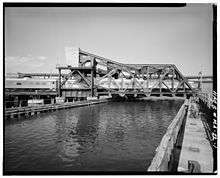Charles River Bridge (Commuter Rail)
| Charles River Bridge | |
|---|---|
 Charles River Bridge in closed position with a train | |
| Coordinates | 42°22′08″N 71°03′55″W / 42.36898°N 71.06529°WCoordinates: 42°22′08″N 71°03′55″W / 42.36898°N 71.06529°W |
| Carries | rail traffic over 4 tracks, split between the two bridges |
| Crosses | Charles River |
| Locale | Boston, Massachusetts |
| Characteristics | |
| Design | single-leaf, through-truss, rolling bascule bridge |
| Material | steel |
| Total length | 92 feet (28 m) (±5 feet (1.5 m)) |
| Number of spans | 1 |
| Piers in water | 0 |
| History | |
| Designer | Keller & Harrington, Chicago[1] |
| Opened | 1931[1] |
 | |
The Charles River Bridge is a pair of railroad single-leaf, through-truss, rolling bascule bridges across the Charles River that connects North Station in Boston, Massachusetts to MBTA Commuter Rail lines in northern Massachusetts.
Design and construction
These bridges were designed by Keller & Harrington of Chicago, Illinois and built by the Phoenix Bridge Company of Phoenixville, Pennsylvania. Each bridge uses a 629-short-ton (571 t) over-head concrete counterweight. Originally, there were four bridges, but only two of them remain.[1]
See also
References
- 1 2 3 "Boston & Maine Railroad, Charles River Bridges, Charles River, North Station vicinity, Boston, Suffolk County, MA". Washington, DC: Historic American Buildings Survey/Historic American Engineering Record. 1984. pp. 2–3. Retrieved 2009-07-16.
External links
| |||||||||
This article is issued from Wikipedia - version of the Thursday, February 05, 2015. The text is available under the Creative Commons Attribution/Share Alike but additional terms may apply for the media files.